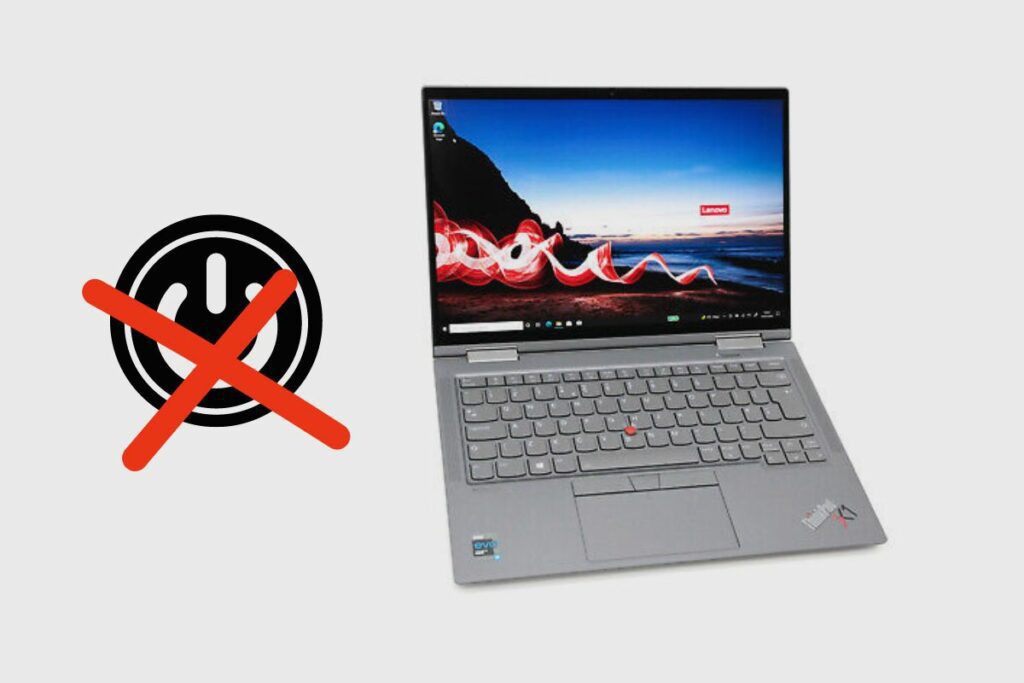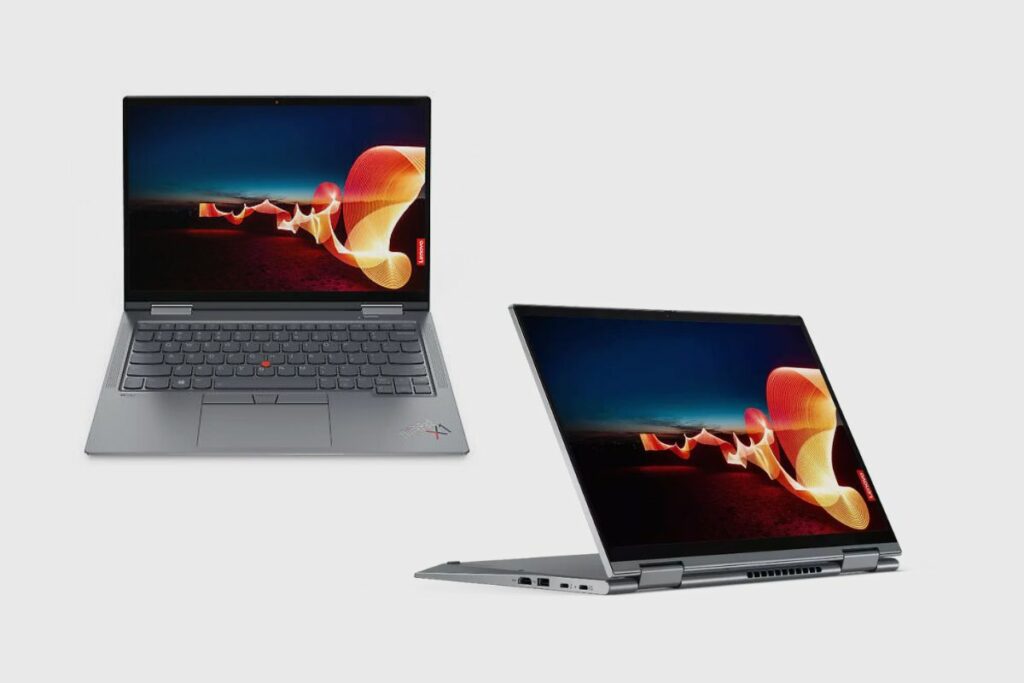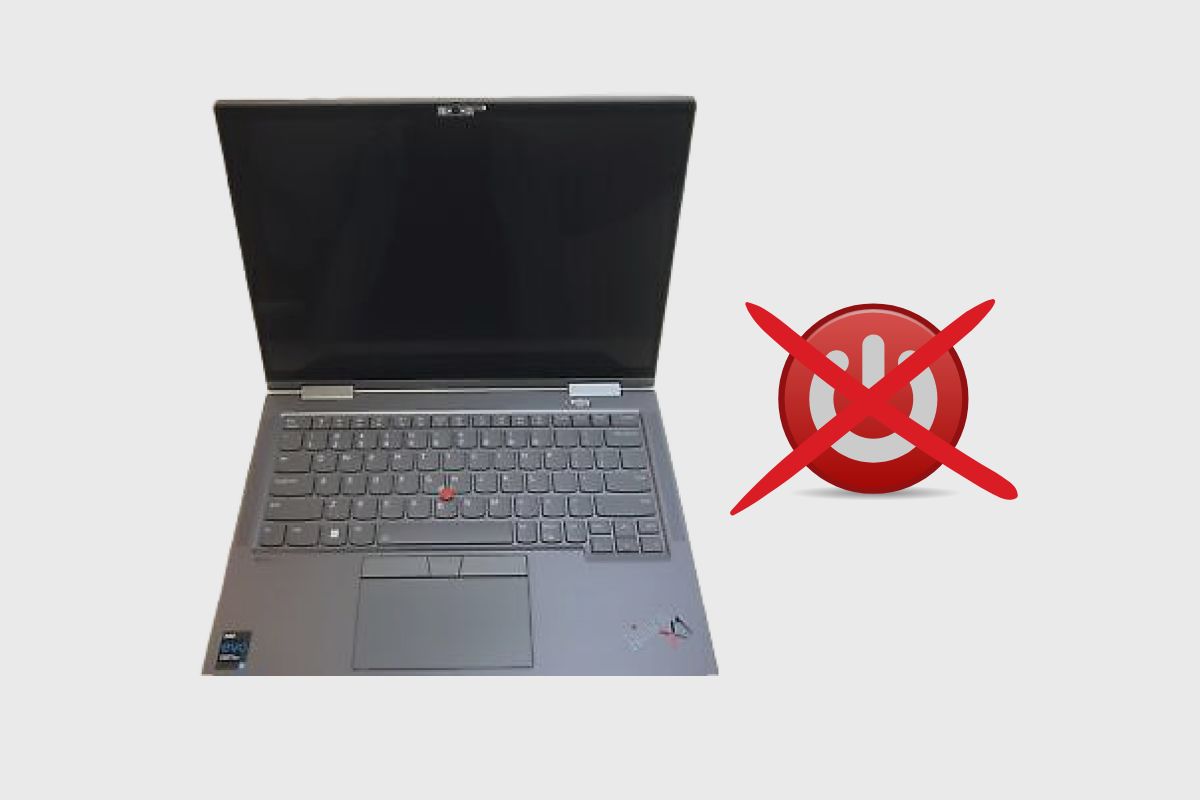It can be very frustrating when your laptop refuses to turn on, especially when it is your new Lenovo ThinkPad X1 Yoga Gen 6. There are a variety of reasons why your laptop may not be turning on. It could be that your charger is not working, your battery is not working, or your laptop’s motherboard may have been damaged.
There are many factors to consider when trying to turn on your laptop; the batteries, the chargers, and even the motherboard could all be having issues. And in this article, I’ll be showing you several things you can do to fix your laptop and get it to turn on.

My Lenovo ThinkPad X1 Yoga Gen 6 Won’t Turn On
If your Lenovo ThinkPad X1 Yoga Gen 6 won’t turn on, then it could be down to several things. Either your battery or charger could be faulty, or your motherboard may be damaged. So, you must go through several options to figure out what the problem could be, and depending on the issue, you could either fix it yourself or take it in for repairs.
How to Turn on My Lenovo ThinkPad X1 Yoga Gen 6 that Won’t Turn On
If your Lenovo ThinkPad X1 Yoga Gen 6 is not turning on, there are a few things you can do to fix your laptop and get it to turn on. The first thing you are going to do is disconnect your charger, then take a Philips head screwdriver and unscrew the bottom cover of your laptop. At the base of your laptop, you should see five screws around it.
Take your screwdriver and remove all of those bolts. Then, once the base plate has been removed, you can proceed to remove your battery. Once that has been done, you will need to flip the laptop over and hold down the power button for one minute so that you can remove any static within the laptop.
Usually, the problem with your laptop is a heavy buildup of static within its motherboard. When your laptop is close to static-heavy objects like a blanket, pets, or shaggy surfaces, static tends to build up on the device. Once you have held the power button for one minute you can then put your battery back into the system and plug your charger in. However, you shouldn’t screw back your base plate just yet.
If your laptop still hasn’t come on, after that, you will need to remove your battery and charger again, press the power button for ten seconds, place your battery inside, and wait to see if it turns on. If it turns on, then the problem may be with your charger. However, if your laptop doesn’t come on, then you will need to remove the battery again, but this time plug in your charger and see if it comes on. If it turns on, then the problem is with your battery.
However, if that doesn’t work, then you will need to perform a BIOS reset on your laptop. With the internals of your laptop exposed, you should be able to see your CMOS battery. It is usually near your battery back, and it looks like a round watch battery. It could either be wrapped in conductive tape or not.
Either way, you will need to remove your COMS battery from the laptop for a few seconds. Once that is done, plug everything back in and turn on your laptop. However, since you removed your CMOS battery, your laptop has had its BIOS reset, and you will need to change your date and time.
To reset your date and time on your laptop, you will need to press F12 or F2 on your keyboard a few times until the BIOS menu comes up. Once your BIOS menu comes up, you will need to go to the configuration setup and then set up your date and time.
Once that is done, you can then proceed to boot up your laptop normally. However, if you have tried everything here and your laptop still doesn’t come on, then your motherboard may have been damaged, and you will need to take it in to be repaired.

Here are Nine Solutions to the Lenovo Laptop or Thinkpad Black Screen Problem
Lenovo ThinkPads are among the most popular devices on the market due to their impressive performance, sleek design, and cutting-edge features. However, some users might face a frustrating issue where their device’s screen goes black and doesn’t turn on. This issue can be caused by various reasons, such as hardware malfunctions, outdated drivers, or software issues.
So I’ll be showing you nine effective solutions to resolve the ThinkPad black screen issue.
1. Check the Power Source
2. Remove external devices
3. Reset BIOS Settings
4. Use Safe Mode to troubleshoot
5. Update drivers and software
6. Fix graphics card issues
7. Check display connections
8. Perform a system restore
9. Seek professional help if necessary
The above-mentioned fixes will resolve most black screen issues on Lenovo laptops and ThinkPads. However, if the problem persists, it might indicate a hardware issue that requires professional attention. Let’s take a closer look at each of these solutions and how to implement them step-by-step.
1. Hardware issues such as disc or graphic card issues
Lenovo laptops are known for their reliability and performance, but even the best machines can experience hardware errors. One of the most common hardware errors that Lenovo laptops, including the ThinkPad X1 Yoga Gen 6, encounter is a black screen issue. This is a frustrating problem that may prevent you from using your computer.
Several potential hardware errors could cause the black screen issue. One of the most common culprits is internal cable damage or wear. This could result in a loss of connectivity or data transmission between the laptop’s components. When the internal cable connection is compromised, it could prevent the laptop from booting up and displaying properly.
Overheating is another factor that could cause hardware errors like a faulty graphics card, which could ultimately lead to a black screen issue. Graphics cards are essential for running complex visual applications and games smoothly. Laptops may experience damage from overheating, which can lead to issues with the video display. If a laptop overheats, the graphics card may be affected, resulting in incorrect video output.
Hard disc errors can happen for several reasons, including power outages, hardware malfunctions, subpar system maintenance, infections, or human error. The computer can become unable to access stored data or show anything as a result of these issues.
A black screen issue could also be brought on by graphics card issues. It may result in stuttering, screen glitches, blue or black screens, or excessive fan noise if the graphics card is not working properly. These early warning indicators point to the need for graphics card repair before a serious issue, such as a black screen issue, arises.
Hardware errors are a common cause of black screen issues on Lenovo laptops. These errors could range from internal cable damage to hard disc errors or graphics card failures. It’s essential to identify the root cause of the problem and seek professional help for effective solutions.
2. Windows OS Gets Abnormal
When it comes to common issues with Lenovo laptops, a black screen caused by abnormal Windows operating system (OS) functionality can be a frustrating problem. This issue arises when there is a malfunction that disrupts the display of your Windows OS on the laptop screen.
Several underlying causes could lead to this issue, like hard disc errors, power outages, viruses, mismatched versions, and power fluctuations. One of the first things you should check for is bad sectors on the hard disc. Corrupt program files due to bad sectors can cause serious issues in the operating system, including a black screen.
While looking for bad sectors, be aware of any strange or unexpected behaviour from the Windows OS. This could include slow operations, unusual folder changes, or system crashes. These could all indicate issues with the OS itself, which could lead to a black screen.
Keeping your versions matched and free of viruses or malware is also important to ensure proper Windows OS functioning. Any mismatches or infections could cause disruption, ultimately leading to a black screen.
It’s also important to be aware of power surges or fluctuations, which can be a behind-the-scenes cause of abnormal Windows OS functioning. These fluctuations can cause temporary issues with the operating system, such as software corruption or even hardware failure.
Overall, it’s important to monitor your Lenovo laptop for any signs of abnormal Windows OS operation, including the appearance of a black screen. When troubleshooting the underlying causes, focus on bad sectors, strange OS behaviour, and power-related issues to get your laptop back up and running as quickly as possible.
3. Faulty Laptop Battery
One of the most common reasons why your Lenovo ThinkPad X1 Yoga Gen 6 won’t turn on is due to a faulty laptop battery. When your laptop battery is not functioning properly, it can prevent your system from powering up or cause it to shut down unexpectedly. This can be a frustrating situation to deal with, especially if you depend on your laptop for work or personal use.
The first thing you should do if you suspect your laptop battery is faulty is check its status. To do this, remove the battery from your laptop and inspect it for any signs of damage or corrosion. If you see any physical damage, such as cracks or leaks, then it’s likely that your battery is faulty and needs to be replaced.
If there are no visible signs of damage, then you can try to reset the battery. To do this, follow these steps:
1. Shut down your laptop and remove the battery.
2. Press and hold the power button for at least 15 seconds.
3. Reinsert the battery and try turning on your laptop.
If your laptop still doesn’t turn on, your battery may have run out of charge. In this case, connect your laptop to a power source using the power cord and try turning it on. If your laptop still doesn’t turn on, then it’s likely that your battery is faulty, and you need to replace it.
When purchasing a new battery, make sure it’s compatible with your Lenovo ThinkPad X1 Yoga Gen 6. It’s also advisable to buy from a reputable seller to ensure that you’re buying a high-quality product. Once you have the new battery, you can instal it on your laptop, and your laptop should power on as expected.
So, if your Lenovo ThinkPad X1 Yoga Gen 6 won’t turn on, the issue might be due to a faulty laptop battery. You can try resetting the battery first before replacing it, but if that doesn’t work, then replacing it is the best solution. By following these tips, you can get your laptop up and running once again.
4. Faulty Laptop Display
If you are experiencing no display screen, lines or dots on the screen, a dimmed screen, the wrong colour display, or a distorted screen, you might have a faulty laptop display. These are common symptoms that indicate there’s something wrong with your screen.
The causes of these issues could be damaged ports or sockets connecting the screen to the keyboard, graphical card errors, or software-related problems. If the issue is software-related, you can try updating your display driver or running a virus scan to see if that solves the problem.
You can update your display drivers by following these steps
Step 1: Visit the Lenovo Support website
Start by going to the official Lenovo Support website and choosing “Laptops & Netbooks” > “ThinkPad X Series” > “ThinkPad X1 Yoga 6th Gen (Type 20XY, 20Y0).”
Step 2: Go to the Downloads area of the website.
When you’ve found your device, click the “Downloads” tab and choose “Driver List.” You can pick the drivers and software you want to download and instal from this page.
Step 3: Choose the appropriate operating system.
Before downloading any files, make sure you have the right operating system and version installed on your device.
Step 4: Download the required software and drivers.
To begin the download process, select the drivers and software you require and click the “Download” button.
Step 5: Set up the software and drivers
Locate the driver file and double-click it to launch the installation procedure after the files have finished downloading. To finish the installation, adhere to the on-screen instructions.
These instructions will help you keep your Lenovo ThinkPad X1 Yoga 6th Gen up-to-date with the most recent drivers and software, ensuring optimum performance. Keep in mind to frequently check for firmware updates to keep your gadget operating at peak performance.
If the problem persists, it could be related to hardware issues such as a faulty display driver, damaged cables or connectors, or even a problem with the logic board. In this case, it’s recommended to seek professional help to diagnose and fix the issue.
5. Device Overheating Continually
The Lenovo ThinkPad X1 Yoga Gen 6 is known for its exceptional performance and reliability. However, like any other laptop, it is prone to some issues that may affect its regular operation. One common problem faced by users is the device overheating continually, leading to a black screen issue. Fortunately, there are some effective solutions to address this problem.
Firstly, it is essential to clean the laptop’s cooling fan regularly using a clean cloth. Over time, the cooling fan can clog up with dust and grime, leading to overheating. By cleaning the fan, the airflow is restored, reducing the chances of overheating. Compressed air is also an effective tool to blow out any debris stuck in the fan blades.
Secondly, it is crucial to place the laptop on a hard, flat surface. This ensures enough space beneath the device, allowing heat to be released freely. Placing the laptop on soft surfaces like a bed or cushion can restrict airflow, leading to overheating.
Thirdly, updating the driver software for the cooling fan can ensure that it is functioning optimally, reducing the chances of overheating. The latest driver software can help the fan adjust to the laptop’s temperature, ensuring that it operates efficiently without causing overheating issues.
Lastly, consider purchasing a laptop cooling pad. These pads can help distribute heat evenly, ensuring that the laptop remains cool at all times. The cooler mat can also elevate the laptop, ensuring that it is on a hard, flat surface, allowing heat to be released freely.
A Lenovo ThinkPad X1 Yoga Gen 6 black screen issue caused by device overheating can be frustrating, but with these effective solutions, it can be addressed effectively. By following these tips, users can enjoy the seamless operation of their laptops without worrying about overheating issues.
6. Issues with Power Supply
Issues with the power supply of a device, especially a laptop, can be frustrating and disruptive. When your Lenovo ThinkPad X1 Yoga Gen 6 won’t turn on, the first thing to check is the power supply. In this article, we will discuss six common power supply issues and provide tips on how to troubleshoot them.
1. Faulty power cord: A faulty power cord is one of the most common power supply issues. If the cord is damaged or not properly connected, your laptop won’t receive power. Check the cord for any physical damage, such as cuts or fraying. If you suspect it’s faulty, try using a different power cord.
2. Power adapter issues: The power adapter is the part that converts AC to DC, and it can also become faulty. Look for signs of damage to the power adapter, such as burned-out tips or frayed wires. If you suspect the power adapter is not functioning correctly, try using a different adapter.
3. Battery issues: If the battery is damaged or not charged correctly, your laptop won’t turn on. Check the battery compartment for any signs of damage or malfunction. Try connecting the laptop directly to a power source without the battery to see if that solves the problem.
4. Internal cables: Internal cables connecting the power supply to the motherboard may come loose or become damaged, causing power supply issues. Disassemble your laptop and check the cables if you suspect this is the issue.
5. AC adapter issues: If the AC adapter is not working correctly, it can cause power supply issues. Try connecting the laptop to a different AC outlet to see if the issue persists.
6. Faulty memory module: A faulty memory module can also cause power supply issues. If the laptop does not turn on, try removing and reinstalling the memory modules.
Power supply issues can be frustrating, but they are usually easy to troubleshoot. By following these tips, you can quickly identify and solve the problem. If the issue persists, it is best to seek professional assistance.
Conclusion
If you have been finding it hard to turn on your Lenovo ThinkPad X1 Gen 6, then please go through all of the steps I have listed for you. They should be able to get your laptop up and running in no time. However, if you have tried everything and your laptop is still not coming on, you will need to take it to a registered Lenovo repair shop to get it fixed.
Related Posts:
References:
- About the Lenovo ThinkPad.

